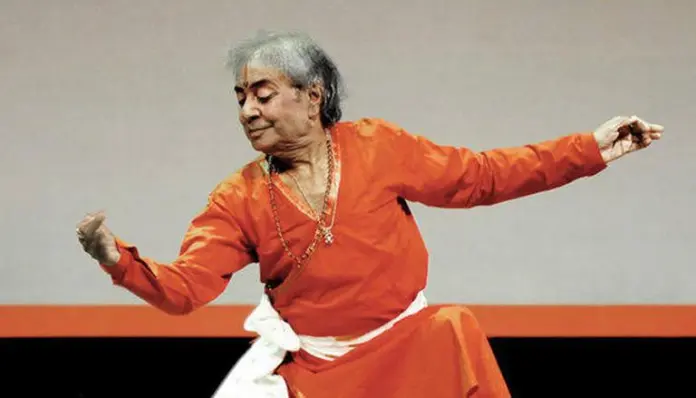
Pandit Birju Maharaj was more than just a dancer—he was an artist, a storyteller, a visionary who revolutionized Kathak, one of India’s most revered classical dance forms. With unmatched grace, expressive storytelling, and rhythmic brilliance, he captivated audiences across the world and redefined Kathak for generations to come. A torchbearer of the Lucknow Gharana, Birju Maharaj blended tradition with innovation, making the dance form accessible, dynamic, and ever-evolving. His contributions extended beyond the stage—he was also a gifted musician, poet, and choreographer, leaving behind a legacy that will be remembered for centuries.
His dance was not just about movement; it was about emotion, rhythm, and poetry coming together in perfect harmony. He could tell entire stories through his expressions alone, portraying everything from the playful mischief of Krishna to the royal elegance of the Mughal courts. With each delicate movement of his hands, each subtle change in his facial expressions, he breathed life into his performances. The sound of his ghungroos (ankle bells) was like a conversation with the audience, filled with intricate rhythms, sudden bursts of energy, and moments of serene beauty.
Early Life: A Born Dancer
Pandit Birju Maharaj was born on February 4, 1938, in Lucknow, into a family of legendary Kathak dancers. His real name was Brijmohan Mishra, but he was affectionately called “Birju” from childhood. Dance ran in his blood—his father, Achhan Maharaj, was a renowned Kathak master, and his uncles, Shambhu Maharaj and Lachhu Maharaj, were also stalwarts of the art. However, his journey was not easy. His father passed away when he was still a child, and the responsibility of carrying forward the Kathak tradition fell upon his young shoulders.
Despite his loss, Birju Maharaj displayed extraordinary talent from an early age. He was trained rigorously by his uncles, mastering the intricate footwork (tatkaar), graceful movements, rhythmic variations (layakari), and the powerful storytelling expressions (abhinaya) that define Kathak. By the age of seven, he was already performing on stage, and by his teenage years, he was recognized as a rising star in Indian classical dance.
Master of Kathak: The Rise of a Legend
By the time he was in his early twenties, Birju Maharaj had established himself as a true maestro of Kathak. He became a prominent teacher at Bharatiya Kala Kendra (now Kathak Kendra) in Delhi, where he trained countless students. His unique approach to teaching made Kathak more engaging, as he encouraged students to explore their creativity while maintaining the purity of the tradition. He later founded Kalashram, a dance school dedicated to preserving and evolving Kathak.
His performances were legendary, filled with grace, energy, and depth. He was known for his ability to create spontaneous compositions on stage, playing with rhythm and time cycles effortlessly. His mastery over “padhant” (reciting rhythms) was unparalleled, and he could produce complex rhythmic patterns purely through his voice before performing them with his feet. He believed that rhythm was a language, and he spoke it fluently.
Beyond dance, Birju Maharaj was also a talented musician and poet. He composed music, wrote poetry, and often sang during his performances, adding an extra dimension to his storytelling. His deep understanding of Hindustani classical music allowed him to collaborate with some of India’s greatest musicians, including tabla maestro Pandit Kishan Maharaj and sitar legend Pandit Ravi Shankar.
Contributions to Films and Music
Birju Maharaj was not just a dancer—he was also an accomplished singer, composer, and choreographer. He lent his expertise to Indian cinema, choreographing iconic dance sequences for films like:
- “Shatranj Ke Khiladi” (1977) – Directed by Satyajit Ray
- “Devdas” (2002) – Choreographed the famous “Kaahe Chhed Mohe” for Madhuri Dixit
- “Bajirao Mastani” (2015) – Designed the breathtaking “Mohe Rang Do Laal” sequence
- “Vishwaroopam” (2013) – Worked with Kamal Haasan on a unique blend of dance and martial arts
His contributions brought Kathak into mainstream cinema while maintaining its authenticity.
Connection with Banaras (Varanasi)
Though he was born in Lucknow, Birju Maharaj shared a deep connection with Varanasi (Kashi), a city renowned for its cultural heritage. He often performed at the ghats of the Ganges, and his family had strong ties to the Banaras classical music and dance traditions. The spiritual aura and artistic atmosphere of Kashi deeply influenced his dance, adding layers of devotion and storytelling to his performances. He often spoke about how the rhythmic beats of tabla and pakhawaj in Kashi’s temples and streets inspired his choreography.
Awards and Recognition
For his immense contributions to Indian classical dance, Birju Maharaj received numerous prestigious awards, including:
- Padma Vibhushan (1986) – India’s second-highest civilian award
- Sangeet Natak Akademi Award – Recognizing his excellence in dance
- Kalidas Samman – Honoring his lifetime achievement
- National Film Award for Choreography – For his exceptional work in Indian cinema
Legacy and Passing
Pandit Birju Maharaj passed away on January 17, 2022, leaving behind a rich legacy of dance, music, and artistic expression. His influence can be seen in every Kathak performance today, as his students and admirers continue to carry forward his vision.
He was not just a dancer but a storyteller, a musician, and an innovator who kept the soul of Kathak alive while taking it to new heights. His legacy continues to inspire generations of artists, proving that true art knows no boundaries of time or tradition.
Pandit Birju Maharaj was not just a dancer—he was a phenomenon, a true embodiment of Indian classical art. His mastery of Kathak, his ability to tell stories through movement, and his deep connection to music and rhythm made him one of the most celebrated artists of all time. He took an ancient tradition and breathed new life into it, ensuring that it remained relevant across generations.
His influence extended beyond the stage, reaching the world of cinema, music, and education. Whether it was through his spellbinding performances, his innovative teaching methods, or his cinematic masterpieces, he left an indelible mark on India’s cultural landscape.